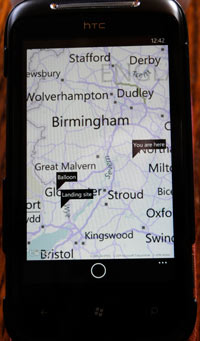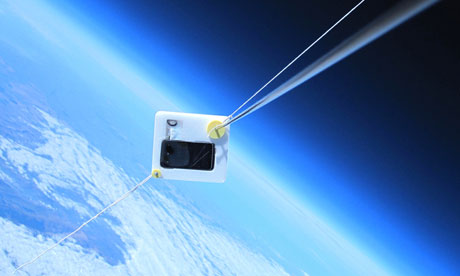WP7 goes sky high!
The University of Southampton developed an app following a balloon 70,000 feet above the ground into the Earth's outer atmosphere. In Flight Mode, the app installed on the handset was able to record and transmit GPS and location data part of the way up and down.

The team from Southampton University launched the HTC 7 Trophy smartphone for atmospheric research. The School of Engineering Science team worked with Microsoft UK, DPE team to develop a Windows Phone 7 application to help track the location of the handset and balloon, and predict its ultimate landing site. In Flight Mode, the app installed on the handset was able to record and transmit GPS and location data part of the way up and down into the Microsoft Azue cloud services.

The HTC 7 device while within range of mobile networks plotted the latest data and predicted a landing site on a Bing map. The flight was part of the university's Astra project – Atmospheric Science Through Robotic Aircraft. "We want to explore the outer atmosphere using low-cost high-altitude unmanned aircraft," "We are collecting data which will then plug in to various atmospheric science projects, monitoring pollutants such as volcanic ash for example, and informing the science behind modelling the climate and earth system in general." said research fellow Andras Sobester.
The positioning data was sent to a Windows Azure server, which did the number-crunching work to calculate its course. The software and app was the work of developer Segoz, working with the university team.
Why use a Windows Phone to do this? The need to reduce the "payload" on the balloon is what made a smartphone appealing, but why Windows Phone 7 rather than, say, an iPhone or Android handset?
"We looked at iPhone, but objective C is just not for me, on a personal level," says Johnston. "I love my Visual Studio and do a lot of .Net development, so I didn't need to learn any new skills for this. The key thing is that we're not doing all the calculations on the phone itself: Azure comes in for the serious backend processing.
"Johnston said he's looking forward to Microsoft extending the Bluetooth stack in Windows Phone 7, which would enable a handset to communicate with more on-board devices. One use for this might be to transmit data via satellite to track the entire flight rather than just the parts within range of a GSM network. Meanwhile, other sensors, will enable the phones to record more useful data.
Geoff Hughes, Academic Team Lead in Microsoft's Developer Platform and Evangelism group, says the app's Hunter Mode shows potential for other kinds of scientific research, when there is a wider audience of people who would be interested in following events."If you could get a whole series of people following a scientific experiment in this way, they could potentially take part in the project," he says. "It's an exciting spin on trying to get the community involved with what is a very fascinating science project."
